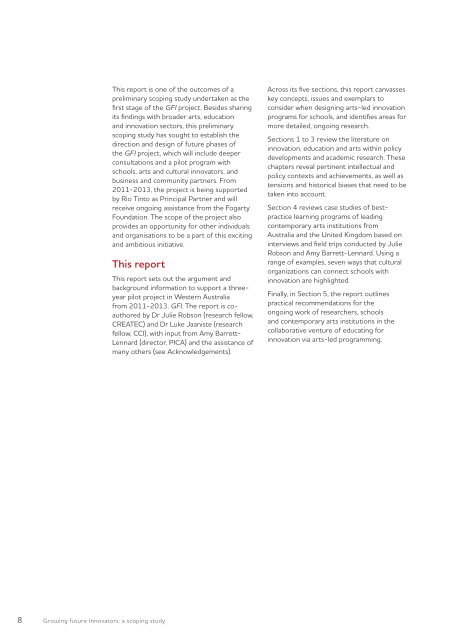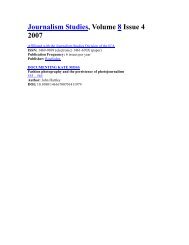GrowinG Future innovators - ARC Centre of Excellence for Creative ...
GrowinG Future innovators - ARC Centre of Excellence for Creative ...
GrowinG Future innovators - ARC Centre of Excellence for Creative ...
You also want an ePaper? Increase the reach of your titles
YUMPU automatically turns print PDFs into web optimized ePapers that Google loves.
8<br />
This report is one <strong>of</strong> the outcomes <strong>of</strong> a<br />
preliminary scoping study undertaken as the<br />
first stage <strong>of</strong> the GFI project. Besides sharing<br />
its findings with broader arts, education<br />
and innovation sectors, this preliminary<br />
scoping study has sought to establish the<br />
direction and design <strong>of</strong> future phases <strong>of</strong><br />
the GFI project, which will include deeper<br />
consultations and a pilot program with<br />
schools, arts and cultural <strong>innovators</strong>, and<br />
business and community partners. From<br />
2011-2013, the project is being supported<br />
by Rio Tinto as Principal Partner and will<br />
receive ongoing assistance from the Fogarty<br />
Foundation. The scope <strong>of</strong> the project also<br />
provides an opportunity <strong>for</strong> other individuals<br />
and organisations to be a part <strong>of</strong> this exciting<br />
and ambitious initiative.<br />
This report<br />
Growing future Innovators: a scoping study<br />
This report sets out the argument and<br />
background in<strong>for</strong>mation to support a threeyear<br />
pilot project in Western Australia<br />
from 2011-2013. GFI. The report is coauthored<br />
by Dr Julie Robson (research fellow,<br />
CREATEC) and Dr Luke Jaaniste (research<br />
fellow, CCI), with input from Amy Barrett-<br />
Lennard (director, PICA) and the assistance <strong>of</strong><br />
many others (see Acknowledgements).<br />
Across its five sections, this report canvasses<br />
key concepts, issues and exemplars to<br />
consider when designing arts-led innovation<br />
programs <strong>for</strong> schools, and identifies areas <strong>for</strong><br />
more detailed, ongoing research.<br />
Sections 1 to 3 review the literature on<br />
innovation, education and arts within policy<br />
developments and academic research. These<br />
chapters reveal pertinent intellectual and<br />
policy contexts and achievements, as well as<br />
tensions and historical biases that need to be<br />
taken into account.<br />
Section 4 reviews case studies <strong>of</strong> bestpractice<br />
learning programs <strong>of</strong> leading<br />
contemporary arts institutions from<br />
Australia and the United Kingdom based on<br />
interviews and field trips conducted by Julie<br />
Robson and Amy Barrett-Lennard. Using a<br />
range <strong>of</strong> examples, seven ways that cultural<br />
organizations can connect schools with<br />
innovation are highlighted.<br />
Finally, in Section 5, the report outlines<br />
practical recommendations <strong>for</strong> the<br />
ongoing work <strong>of</strong> researchers, schools<br />
and contemporary arts institutions in the<br />
collaborative venture <strong>of</strong> educating <strong>for</strong><br />
innovation via arts-led programming.




![Plebiscite (Riegert chapter) revised FINAL [Feb 14].pdf](https://img.yumpu.com/8710373/1/190x245/plebiscite-riegert-chapter-revised-final-feb-14pdf.jpg?quality=85)